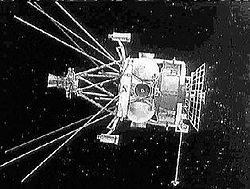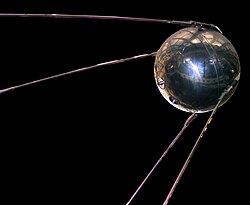Space Race 1957-1975 black text
Autor/Urheber:
Attribution:
Das Bild ist mit 'Attribution Required' markiert, aber es wurden keine Informationen über die Attribution bereitgestellt. Vermutlich wurde bei Verwendung des MediaWiki-Templates für die CC-BY Lizenzen der Parameter für die Attribution weggelassen. Autoren und Urheber finden für die korrekte Verwendung der Templates hier ein Beispiel.
Shortlink:
Quelle:
Größe:
1350 x 1080 Pixel (398839 Bytes)
Beschreibung:
This image takes significant events from the timeline of the Space Race from 1957 through 1975 and plots them along the y-axis in order of relative difficulty of those accomplishments. All human spaceflight programs are graphed along with leading events for unpiloted probes. It is all put in context of government leadership and selected technological, social and military events of that period as they happened under the shadow of the nuclear arms race. Three separate flows are charted. The first being unpiloted space probes toward the lunar goal as they evolved from Sputnik/Explorer to the lunar impactors, landers, rovers and sample return missions. The second (but PRIMARY in significance) being human spaceflight from Gagarin/Shepard up to the pinnacle of the Apollo Moon missions and back down to the Salyut/Skylab stations, then cooling off with Apollo/Soyuz (not covering the continued story of Shuttle/Buran and Mir/ISS). The third flow, shown at the top of the chart, covers leading interplanetary probes as they attained certain goals with varying success. Ending the timeline at Apollo/Soyuz puts achievements such as the Viking landers and Voyager missions off to the right of this chart. The parenthetical years shown at the right edge of the chart mark when that particular level was accomplished by the other country, such as Sally Ride becoming the first U.S. female in space in 1983, twenty years after Valentina Tereshkova. (Minority and non-government breakthroughs that happen after the mid-70s timeframe are not shown in this chart.) Displaying these accomplishments graphically makes it easy to see how the U.S. started behind but eventually caught up and surpassed the Soviet Union. The U.S. was a year behind in getting a "Man in Orbit", and then jumped ahead during the Gemini Program. The Soviets did not accomplish rendezvous and docking until three years after the U.S. did. The Soviets came very close to beating the U.S. in sending people around the Moon, but the Zond 5 spacecraft and subsequent attempts, although capable of carrying cosmonauts to the Moon, were not able to achieve a reliably survivable return to Earth. Major setbacks were followed by multiple failures of their N-1 Moon rocket and the Soviets never sent any cosmonauts beyond Earth orbit. With six Apollo Moon landings, the U.S. resoundingly won the Moon Race. The Soviets continued to explore the Moon with robotic probes. Both nations continued sending probes to explore the solar system. Through diplomatic negotiations, a new era of Detente was ushered in to significantly calm the fear of nuclear war. After years of intense competition in space, the race was relaxed in 1975 with a dramatic display of cooperation on the Apollo-Soyuz mission.
This chart was first constructed in 1997, with public distribution offered in January 2002, via Usenet.
This chart was first constructed in 1997, with public distribution offered in January 2002, via Usenet.
Lizenz:
Credit:
Relevante Bilder
Relevante Artikel
Wettlauf ins AllAls Wettlauf ins All wird der Wettbewerb in den 1950er und 1960er Jahren zwischen den Vereinigten Staaten und der Sowjetunion um Pionierleistungen und Vorherrschaft in der Raumfahrt bezeichnet. .. weiterlesen
WeltraumzeitalterAls Weltraumzeitalter wird die Epoche des technischen Fortschritts ab Mitte des 20. Jahrhunderts bezeichnet. Sie war mitgeprägt durch die Weltraumforschung, Raumfahrttechnologien und die durch diese Entwicklungen entstandenen Einflüsse in vielen Bereiche des täglichen Lebens. .. weiterlesen














